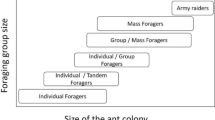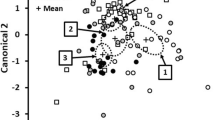Summary
Leptothorax unifasciatus ant colonies occupy flat crevices in rocks in which their brood is kept in a single cluster. In artificial nests made from two glass plates sandwiched together, designed to mimic the general proportions of their nest sites in the field, such colonies arrange their brood in a distinct pattern. These patterns may influence the priority with which different brood are tended, and may therefore influence both the division of labour and colony demography. Different brood stages are arranged in concentric rings in a single cluster centred around the eggs and micro-larvae. Successively larger larvae are arranged in progressive bands away from the centre of the brood cluster. However, the largest and oldest brood items, the prepupae and pupae, are placed in an intermediate position between the largest and most peripheral larvae and the larvae of medium size. Dirichlet tessellations are used to analyze these patterns and show that the tile areas, the area closer to each item than its neighbours, allocated to each type of item increase with distance from the centre of the brood cluster. There is a significant positive correlation between such tile areas and the estimated metabolic rates of each type of brood item. The ants may be creating a “domain of care” around each brood item proportional to that item's needs. If nurse workers tend to move to the brood item whose tile they happen to be within when they have care to donate, they may apportion such care according to the needs of each type of brood. When colonies emigrate to new nests they rapidly recreate these characteristic brood patterns.
Similar content being viewed by others
References
Barker G, Grimson M (1990) The physics of muesli. New Scient 126 (1718):37–40
Camazine S (1991) Self-organizing pattern formation on the combs of honey bee colonies. Behav Ecol Sociobiol 28:61–76
Camazine S, Sneyd J, Jenkins MJ, Murray JD (1990) A mathematical model of self-organized pattern formation on the combs of honeybee colonies. J Theor Biol 147:553–571
Clark PJ, Evans FC (1954) Distance to nearest neighbour as a measure of spatial relationships in populations. Ecology 35:23–30
Corbara B, Fresneau D, Lachaud J-P, Leclerc Y, Goodall G (1986) An automated photographic technique for behavioural investigations of social insects. Behav Process, 13:237–249
Deneubourg JL, Goss S, Franks N, Sendova-Franks A, Detrain C, Chretien L (1991) The Dynamics of Collective Sorting: Robot-Like Ants and Ant-Like Robots. In: Meyer JA, Wilson S (eds) Simulations of Animal Behaviour; From Animals to Animats. MIT Press, Cambridge, MA, pp 356–365
Donelly K (1978)Simulation to determine the variance and edge effect of total nearest-neighbour distance. In: Hodder I (ed) Simulation Studies in Archaeology, Cambridge University Press, Cambridge, pp 91–95
Franks NR, Bryant S, Griffiths R, Hemerik L (1990) Synchronization of the behaviour within nests of the ant Leptothorax acervorum (Fabricius) — 1. Discovering the phenomenon and its relation to the level of starvation. Bull Math Biol 52:597–612
Green PJ, Sibson R (1978) Computing Dirichlet tessellation in the plane. Comput J 21:168–173
Hamilton WD (1971) Geometry for the selfish herd. J Theor Biol 31:295–311
Headley AE (1941) Arrangement of brood in nest. Ann Entomol Soc Am 34:649–657
Hölldobler B, Wilson EO (1990) The Ants. Belknap Press of Harvard University Press, Cambridge, MA
Le Masne G (1953) Care of Larvae. Ann Sci Natl Zool 15:1–56
Peakin GJ (1960) Nest temperature and humidity. Ph.D. thesis, University of London
Schmidt-Nielsen K (1984) Scaling: Why is Animal Size so Important? Cambridge University Press, Cambridge
Sudd JH (1967) An Introduction to the Behaviour of Ants. Arnold, London
Sudd JH, Franks NR (1987) The behavioural ecology of ants. Blackie, Glasgow
Wheeler WM (1913) Ants: Their structure, Development and Behavior. Columbia University Press, New York
Author information
Authors and Affiliations
Rights and permissions
About this article
Cite this article
Franks, N.R., Sendova-Franks, A.B. Brood sorting by ants: distributing the workload over the work-surface. Behav Ecol Sociobiol 30, 109–123 (1992). https://doi.org/10.1007/BF00173947
Received:
Accepted:
Issue Date:
DOI: https://doi.org/10.1007/BF00173947




